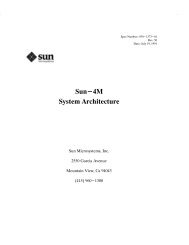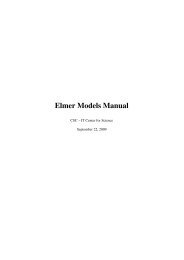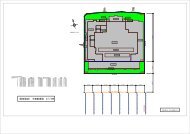Writing Drivers for NetBSD - of index.html
Writing Drivers for NetBSD - of index.html
Writing Drivers for NetBSD - of index.html
Create successful ePaper yourself
Turn your PDF publications into a flip-book with our unique Google optimized e-Paper software.
3 THE AUTOCONF(9) PART OF THE RF(4) DRIVER 25<br />
available as a preprocessor constant RFCCF DRIVE DEFAULT and in is our example<br />
-1. (See 3.1.2 and 2.4 <strong>for</strong> the reason.)<br />
Thus, the driver gets the value <strong>of</strong> the locators from two sides <strong>of</strong> the interface<br />
attribute to which it attaches, i.e. the position, adress, ID, ... under which it is<br />
known to its parent. The one side from which the driver receives the value <strong>of</strong><br />
the locator is the cf loc array <strong>of</strong> the cfdata data structure. These values are the<br />
same as the ones give in the kernels configuration file; they are statically given<br />
at compilation time. The other side is the attach args data structure passed to<br />
the rfmatch function as void *aux. That structure is passed from the parent to<br />
the child when the kernel boots. It there<strong>for</strong>e contains the locator values, that are<br />
actually found in the hardware.<br />
In the above if conditional, the child is checking two conditions: first,<br />
whether or not a wildcard was given as the locator. If so, then the position, address,<br />
ID, ... under which it is known to the parent matches, it returns 1 and the<br />
child driver is attached. If the kernel configuration file did not contain a precise<br />
position, address, ID, ... <strong>for</strong> the child, it has to use the match function to check<br />
if the value <strong>of</strong> the configuration file is identical to the one actually found. If so,<br />
then all’s peachy and the child driver is attached. If not, then the found hardware<br />
configuration does not match the kernel configuration an the child driver must not<br />
be attached. There<strong>for</strong>e, the match function returns 0. This check is necessary to<br />
“nail down” certain locators in the kernels configuration file. For example:<br />
sd2 at scsibus1 target 6 lun 0<br />
Using this mechanism, it is possible to on the one hand use wildcards and<br />
at the same time to “nail down” certain instances <strong>of</strong> a driver to a specific position.<br />
That is another reason why config found() calls config search().<br />
config search() iterates over all children. That’s the only way to find the<br />
“right” child, if no wildcards are used.<br />
3.3.4 rf attach()<br />
void<br />
rf_attach(struct device *parent, struct device *self, void *aux)<br />
{<br />
struct rf_s<strong>of</strong>tc *rf_sc = (struct rf_s<strong>of</strong>tc *)self;<br />
struct rfc_attach_args *rfc_aa = (struct rfc_attach_args *)aux;<br />
struct rfc_s<strong>of</strong>tc *rfc_sc;<br />
struct disklabel *dl;






